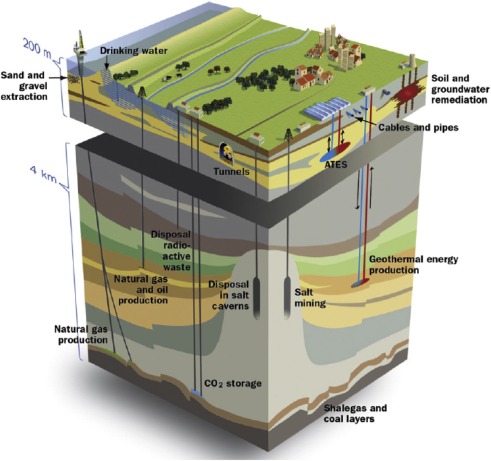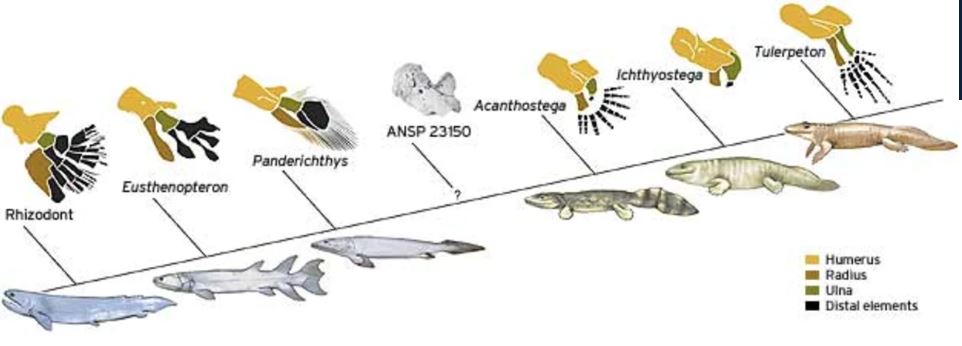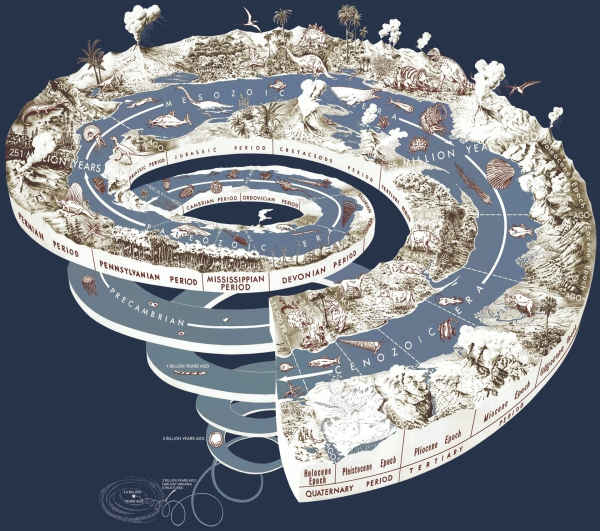WHAT IS BIOSTRATIGRAPHY AND WHY DO WE DO IT?
The rocks at the Earth's surface, and beneath our feet - the "subsurface" - can be characterised and organised based not just on the type of rock they are, but also on the fossils they contain (where the two parts; "bio-" and "-stratigraphy" come from). By analysing the fossils in the rock we can estimate the rock's age and also we can also discover something about the environment in which the sediments that make up that rock were laid down. The fossils that biostratigraphers use to do this can range in size from huge sauropod skeletons, tens of metres in size, right down to an individual grain of pollen, invisible to the naked eye.
We know that some fossil species existed for several million years before they became extinct and that other species may have existed only for a few hundreds of thousands of years during Earth's long and varied history. If we find these fossil species in our rocks we can often date those rocks to within fairly precise time ranges. More importantly, if we find that same fossil species at two or more different localities on Earth, we can correlate (join) those occurrences and begin to drawn up maps of the subsurface because we can "join the dots" between our fossil species occurrences and link together rocks that might be far apart but that were deposited at the same time.

|
These correlations are useful because we often need to know how the rocks beneath our feet are arranged. We may, for example, want to build a dam or a bridge and we need to know if the foundation rocks beneath the soil are hard and stable, or soft and crumbly. We may want to know if an offshore wind-farm can be sited in a suitable area for similar reasons. And yes, even in these days where we are trying to reduce our dependency of fossil fuels, we still need to know the best places for siting the positions of new oil and gas wells and how to produce hydrocarbons with a lower carbon footprint than we have done before. Biostratigraphy is a critical tool in our toolbox needed to understand the subsurface. Biostratigraphy revolves around the knowledge of fossils. Because many of the rock samples biostratigraphers analyse are relatively small, or come from drilled boreholes where much of the rock is smashed up into very small fragments, the fossils many biostratigraphers work with are also small - so small in fact that we have to use microscopes to see them. |
These "microfossils" come from a large variety of animal and plant origins which make up a microscopic world of their own and which often passes us by, unnoticed. Many species of microfossils are living today - two or three groups are hugely important to life on Earth today and in the geological past, as they provide most of Earth's breathable oxygen. Many others are from organisms that occupy relatively low places in the "food web" and are vital for the existence of larger animals that feed on them. Some microfossil groups come from types of organisms that are now extinct on Earth, including one form of microfossil that is believed to be mouth parts of an extinct eel-like creature that was one of our oldest ancestors!

All these microfossils are less than 1mm in size and, in the case of the nannoplankton and pollen, less than 0.01mm
EVOLUTION MAKES IT WORK!
The reason there are so many different forms of life on Earth - and the reason we have many microfossil groups and species that have lived and died throughout Earth's history - is because of evolution. Paleontologists noted long ago that many fossils they found in rocks didn't look anything like the animals (and plants) that live on Earth today, whereas some looked remarkably similar! Most people thought that the unfamiliar fossils were wiped out during the biblical flood ("Noah's flood"), while the familiar fossils survived, because they could not imagine an Earth that was older than just a few thousand years and could not imagine events which occurred before those mentioned in the bible.
A Scottish gentleman and geologist, James Hutton - himself a religious man - realised from looking at the arrangement of some of the rocks in Scotland that there must have been vastly long time-periods involved in order to arrange the rocks in the configurations we see in the present day. He presumed that the age of the Earth should be measured in millions of years (and even hundreds of millions of years) rather than just a few thousand as the bible suggested. You can see some of Hutton's rocks and watch a video of Hutton and his story on our website's front page.
| About 30 years after James Hutton's time a young naturalist from Shrewsbury called Charles Darwin set sail on a five-year voyage around the world which would show - among other things - that members of species were not all absolutely identical and that, in some cases, species would look slightly different if they could be observed in different places, say, on different islands. Darwin wondered why they were different and concluded that different features on the different islands favoured the development of certain characteristics in the animals and plants living on them. |

|
For example, tortoises with long necks were good at feeding on leaves from bushes of medium height off the ground, whereas tortoises with shorter necks fed on leaves and grass closer to the ground. The vegetation, in turn, depended on how well watered each island was. Darwin wondered if animals could adapt to the different environments each island had to offer. If they did, did they consciously change to suit the conditions or was it something they had no conscious control over? How long did it take to change? What happened to those that couldn't or didn't change?

|
|
Darwin eventually concluded that those individuals that were slightly different from their fellows - say, an individual with a slightly longer neck - would have a slightly better chance of surviving during dry periods when ground vegetation disappeared and only bush-like cactuses would grow. If an individual survived the drought, it would pass on that trait of having a slightly longer neck to its offspring who would, in turn, have a slightly better chance of surviving the next drought and passing on their long-necked trait, and so on... Darwin worked out that these small incremental changes must take place over very long time-spans in order for them to make a difference to survival and to create a brand new species of long-necked tortoise; time-spans far longer than than the two or three thousand years the biblical flood would allow. James Hutton's theories - and those that followed him - on the age of the Earth, gave Darwin the time he needed to allow for his changes (which he called "Natural Selection") to take place. |
Of course, we now know these small variations between individuals of the same species are caused by mutations in the organism's DNA and variations caused by the "mixing" of DNA between the parents. If favourable, these mutations or differences (like a slightly longer neck) could be passed on to the organism's offspring. Darwin knew about the principles of inheritance of certain characteristics from the organism's parents (including us!) but he did not know of the mutation mechanism. Nevertheless his conclusions were revolutionary and he has become one of the most influential humans in history.
Small changes, but operating over millions of years, have resulted in the diversity of life we see on Earth today, and during the geological past. It also gives us our grand mosaic of a huge variety of different species that lived during a huge variety of different time periods. It is this vast reservoir of fossil species that allows the biostratigrapher to operate.
Want to find out more? We run short training courses on how Biostratigraphy can be applied throughout many practical situations. Click here to see the Supplementary Notes that accompany our training courses. These are of a much more technical nature.
